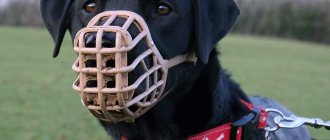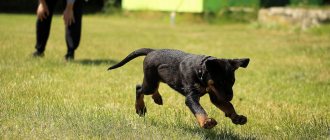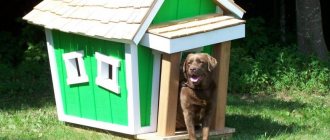Sometimes a dog does not want to settle in its own separate home - a kennel, but prefers to live in the same territory with its owners. But if the dog was bred specifically to guard the local area, such a manifestation of character can become a real problem. How to train a dog to a kennel is the topic of the article. We will learn for what reasons a dog may refuse to live in a kennel, how to eliminate this, and how to rehabilitate a capricious pet.
Basic requirements for housing on the street
To arrange a new home for a dog, you should adhere to the following rules:
- Make the enclosure or kennel spacious, clean, darkened, and well ventilated (no drafts). The height of the viewing opening should be approximately 75% higher than the length from the animal's shoulder to the ground.
- The door is made using a piece of rubber, tarpaulin, with cut longitudinal strips with weighted ends. This will allow the dog to see what is going on outside and stay inside.
Breeds with thick coats and short muzzles are more sensitive to heat exhaustion. A home that provides sufficient shade and optimal flow of fresh air will suit them. Providing a safe place is important, especially if the dog lives on the street and will spend long periods of time there. A properly built kennel can protect a dog from extreme temperatures, wind, rain, snow, and potential predators.
There are two types of enclosures:
- Open – a fence installed around the sleeping area. The structure will be useful for limiting the pet while guests arrive.
- Closed - with a roof, mesh walls, doors. There is a kennel inside.
It is recommended to lay a floor in the room reserved for the dog for additional insulation. Usually it is made of concrete (with wooden flooring) or asphalt, and also inclined so that puddles do not form during washing and after rain. Experts recommend covering the roof with bitumen shingles (to protect against rain or hail).
The doors of the enclosure must open inward and be strong. It is better to choose a strong lock (so that the dog cannot knock it out). General requirements for outdoor enclosures:
| Dog height | Room area |
| More than 65 cm at the withers | 10 m² |
| 50-65 cm | 8 m² |
| Up to 50 cm | 6 m² |
[custom_ads_shortcode1]
Why doesn't a dog want to live in a kennel?
A pet may not want to sleep or live in a kennel for various reasons, but all of them can be easily eliminated.
- The animal may not like the smell of the home or some object inside. It is enough to get rid of the unpleasant aroma or something that irritates the dog, and the problem will be solved.
- If the booth is not new (another pet previously lived in it), then the animal may be uncomfortable being there.
- When a dog does not come into his kennel even in the rain, the house may be too small for him (paws, head sticking out of the kennel).
- The dog may be lonely, so you should periodically communicate with it, play, and take it for a walk. Then he will understand that we still love him and will not protest.
- If a stray dog was taken into an apartment, and now the owners plan for it to live in a kennel, you should pay more attention to it, as it may think that it has been put out on the street again.
Dogs with short hair are prone to frostbite and have difficulty withstanding cold temperatures.
[custom_ads_shortcode2]
Signs of anxiety
The owner may suspect something is wrong after certain actions of the dog. Most often, a pet, while staying at home, tries in any way to harm the things around it and gets rowdy. He can chew on the shoes of household members, tear up the sofa, tear up the carpet, and scatter things. At first glance, this seems like a fairly harmless dirty trick, but such behavior often indicates that the dog is uncomfortable being alone.
A dog alone at home can behave calmly while waiting for its owner
In addition, neighbors may notice signs of your pet’s not entirely normal behavior. For example, the owner leaves for work, returning, and hears from a neighbor in the entrance that she is tired of the howling of the dog. You should be concerned if the dog howls, whines, or barks for a long time after the owner leaves, and not just for a couple of minutes. You can also notice this if you leave a surveillance camera and a bug at home.
Note! Such a purchase will not be superfluous if you often have to leave the dog at home, but want to know if everything is okay with it. Such devices are convenient because you can remotely monitor how your dog is doing from a smartphone.
A long sleep after the owner returns home also indicates something is wrong, if nothing like this happened before. Dogs often try to compensate for their stress by taking a long rest. If the dog is completely healthy and was active before he was left alone, then you should worry about his condition.
Eating problems also arise from stress. When a dog could eat a whole bowl, and sometimes asked for more, and then refuses to eat, it may be showing its protest and reluctance to be alone.
What surprise might the owner discover when returning home?
Training methods
It is not easy to train an adult dog to stay in a kennel. If she won't go to the kennel, the following tips will help solve the problem.
- The animal needs to be allowed to get used to it, allowed to enter a new booth, sniff the surrounding area, and wait until it gets used to the enclosure. To do this, you should gradually leave the house with him in dry, warm weather and introduce him to his future home.
- When a dog enters a new home, it is important to reward it with a treat to develop pleasant associations.
- It is worth putting several of your favorite dog toys in the kennel so that the animal can feel a familiar smell.
- When the dog is in the kennel, it is important not to forget about it and not leave it alone. A simple game and communication will reinforce positive emotions.
- It is better to accustom an animal to a new place in warm weather, since in winter being outside can become stressful for him.
The kennel or enclosure is placed facing the front door so that the owner, if necessary, can quickly assess the dog’s condition.
[custom_ads_shortcode3]
How to train a dog from an apartment to live in the yard?
After an apartment, it is quite difficult to train a dog to live on the street. Follow these basic rules to make things easier:
- Allow your pet to independently enter the booth, sniff it, and get comfortable in the new territory.
- When the animal enters its home, be sure to treat it with a treat and praise it.
- Place a favorite toy or old dog-smelling bedding from your apartment in the kennel.
- At first, do not leave your pet in the kennel alone for a long time.
- To train a dog to a booth, it is better to choose a warm season. In a frosty winter this can become stressful for him.
It is more difficult to accustom an adult dog to an enclosure and a kennel. Prepare for a long process and be patient
Some factors need to be taken into account:
- A sudden change in a dog’s lifestyle can cause stress and negative consequences. It is necessary to give more attention and affection during this period.
- The pet is accustomed to the owner being nearby in the house. During the period of getting used to new conditions, it is advisable to have someone familiar nearby.
- The first days of training should be dosed. Two hours will be enough. If your pet tolerates the novelty well, gradually add more time in the enclosure every day.
- Take your dog home at night. Sleeping in familiar conditions will calm the animal.
Street dog owners share clever tricks that can help:
- Fill a plastic bottle with warm water and place it in the dog house. This “neighborhood” has a calming effect on the pet, and it will quickly settle down.
- Try to feed the animal tasty and satisfying when it is in the enclosure. Give us pieces of meat, cheese and other goodies. The new place should bring good associations.
- Some dog owners install a water sprinkler near the kennel. The dog tries to hide from the splashes and runs into his house.
If neither affection, nor play, nor tricks can accustom an adult dog to street life, you can resort to additional methods:
Leave the enclosure open, do not focus attention on it. When playing with your dog in the yard, casually throw a ball at him. Wait for the dog to bring you the toy, and then be sure to praise him and give him a “yummy” treat.
Start feeding your pet near the open door to the enclosure. Move the food bowl further inside each day until the dog can fully enter the enclosure and eat there. Place something with the owner's scent in the kennel - an old T-shirt or jeans. With a familiar smell it will be easier to get used to new conditions. Wait for the rain and go for a walk. When exposed to rain and cold, the dog often goes into a dry and warm kennel on its own. If she hasn't thought of doing it herself, point her to a hiding place. If she obeys, praise her and reward her with a treat. If the space in the booth allows, show by example that it is safe inside. Call the animal to you, caress it, play with your favorite toy to keep it there longer. Buy a dog “bone” made from veins at a pet store, put it in a kennel and offer to chew it there. Dogs usually readily agree
Wait for the dog to bring you the toy himself, and then be sure to praise him and give him a “yummy.” Start feeding your pet near the open door to the enclosure. Move the food bowl further inside each day until the dog can fully enter the enclosure and eat there. Place something with the owner's scent in the kennel - an old T-shirt or jeans. With a familiar smell it will be easier to get used to new conditions. Wait for the rain and go for a walk. When exposed to rain and cold, the dog often goes into a dry and warm kennel on its own. If she hasn't thought of doing it herself, point her to a hiding place. If she obeys, praise her and reward her with a treat. If the space in the booth allows, show by example that it is safe inside. Call the animal to you, caress it, play with your favorite toy to keep it there longer. Buy a dog “bone” made from veins at a pet store, put it in a kennel and offer to chew it there. Usually dogs readily agree.
Arrangement of the booth
First, choose the material for the kennel: wood, metal, plastic. Plastic buildings are usually lighter and cheaper. They are quite easy to transport, they do not rot, do not require painting, and are easy to wash.
Wood buildings are stronger, more durable, and a better insulator than plastic, so your dog is less likely to overheat inside the kennel. But wood has one significant drawback - rotting.
In addition to plastic and wooden ones, there are also iron booths. They are durable, easy to care for, but uncomfortable and bulky. The roof of the booth must be strong and airtight.
You should definitely consider ventilation; for this you can put the kennel on a pallet or legs.
It is better to choose polystyrene foam as room insulation. They are easy to use, lightweight, and have high thermal insulation properties. Felt is also used instead: it is durable and has good vapor permeability.
The bedding for the booth should not be too large or small. The material is also important for her. Blankets, towels, carpet, hay, straw, and newspapers often become moldy.
The best bedding option is pillows filled with cedar shavings, as the oil from this tree will repel insects. However, it can cause allergies in dogs. To minimize this possibility, fill a small bag with cedar shavings and place it in the kennel to repel fleas and bedbugs.
[custom_ads_shortcode1]
What not to do
When training a dog to a booth or enclosure, dog breeders should not carry out the following actions:
- Forcing your dog into a kennel, as this will only scare him. It is better to slowly, carefully find out what caused this behavior.
- Overwork, force you to repeat the “place” command. It is advisable to gradually increase the intervals of stay in the booth, and the rest of the time to give the animal freedom.
- Overindulge. Everything needs moderation.
- Punish inside the kennel, force the pet into the enclosure.
[custom_ads_shortcode2]
Accustom an adult dog to a chain
The dog should not be placed on a leash immediately after moving to a private home. She should gradually become familiar with the territory and understand that the yard is a safe place. The chain is allowed to be neither short nor too long, the collar is wide, comfortable, and does not squeeze the animal’s neck.
The training rules are almost the same as with a booth. It is necessary to gradually increase the interval the animal is on a leash, reward it for good behavior, pet it, and communicate with it.
It is important to remember that it is easier to train a puppy to a chain than an adult dog. Accustoming a dog to life on the street is a labor-intensive process, but doable. With the right approach, after a while the dog will delight its owners by following the rules it learned during the training process.
Large breeds of dogs feel more comfortable living in a private house with a spacious area. To do this, the owners equip them with booths or enclosures. But it can be very difficult to accustom a puppy, and especially an adult animal, to life in a kennel, especially if the pet has lived in an apartment for some time.
[custom_ads_shortcode3]
Safety in the yard
Monitor your pet's behavior. Perhaps the fence is not high enough and the dog is simply jumping over it.
Carefully inspect the area near the fence. Perhaps there are objects near the fence that help the dog overcome the height of the fence - benches, boxes, chairs and other objects. If they are absent, you will have to make the fence higher. By increasing the height, make the top edge of the fence inclined, making it difficult for the animal to overcome the obstacle.
It happens that dogs dig under the fence and crawl out. To avoid this, wire mesh is dug into the ground. Its ends are directed towards the street, then the animal will not get hurt.
An effective method of protection is a barrier made of large stones laid along the fence. This will make it difficult for your pet to dig and escape from the house.
If your yard fence is made of chain link fence, dig it as deep as possible.
Perhaps there are loopholes in the fence that are sealed to prevent the dog from escaping.
Why does a dog refuse to sleep in a kennel?
There are often situations when all the efforts made by the owner to accustom the pet to the booth turn out to be in vain. There are many reasons why a dog does not enter the kennel and does not sleep in it:
- The inconvenience in the booth itself is an incorrect design, drafts, cold or, conversely, it is too hot inside, an unpleasant smell.
- If the booth has been passed down from a previous pet whose smell remains in it, the animal may refuse to stay in it. This is one of the reasons why the dog does not enter the kennel even in the rain.
- The dog is afraid of the dark or does not like to be alone. This tendency is often observed in animals that have lived in the same room with household members for a long time.
- Individual characteristics of character and behavior.
Each large breed dog needs a separate room on the property. Additional information! In order for the animal to quickly get used to life in a booth, it is best to choose summer or spring for training. In winter and autumn, when it is cold and rainy, the animal may experience severe stress from a sudden change in living conditions, which is why it will flatly refuse to spend the night in a kennel.
[custom_ads_shortcode1]
Insulation of buildings
In winter, the enclosure should be insulated so that the dog does not freeze and feels comfortable.
To do this, you need to follow several recommendations:
- insulate the walls of the building with polystyrene foam, felt, penoplex or mineral wool;
- distribute straw or sawdust on the floor;
- sawdust must be hammered into the space between the walls;
- it is necessary to choose odorless insulation - if the enclosure smells different, the husky may refuse to enter it;
- the insulation should be isolated from the dog, because the animal can chew through the material.
Felt is considered the safest insulation material. In addition to high thermal insulation, the natural material will not harm the health of the pet. If felt is not suitable, you can use mineral wool.
Inappropriate size or uncomfortable conditions
In addition to drafts and cold, the kennel may not be the right size depending on the size of the animal. This will make him very uncomfortable. Recommended house sizes:
| Dimensions of the animal | Booth dimensions |
| Up to 50 cm | 6 m2 |
| From 50 to 65 cm | 8 m2 |
| From 65 cm and more | 10 m2 |
For example, for a German Shepherd, a comfortable enclosure should have an average size of 1.3m*1m*0.7m.
The pet’s desire to spend the night in a separate room depends on the comfort of the created conditions.
[custom_ads_shortcode2]
Booth location
The booth must not only be well insulated and high enough so that water does not flood into it when it rains. It must be positioned correctly on the site. The walls should not allow drafts to pass through. With a comfortable house, the question of how to train a dog to a kennel in the yard will be easier to solve.
The pet's room should be located in such a way that the entire site, outbuildings and house can be clearly seen from it. Attention! The booth should be located away from chicken coops and areas where livestock are kept.
The optimal location is near the fence or close to the wall so that the animal has protection from the wind and direct sunlight.
[custom_ads_shortcode3]
When is it time to teach?
The experience of many breeders suggests that cold weather is a good time for training in many cases. The dogs walk around the kennel, and the coolness will drive them inside the comfortable house for the night. There is also the opposite opinion - you need to train them to the booth in late spring or summer, in warm and dry weather. Bad weather will cause the dog to instinctively stay at home and training will be of little use. But light rain will not be a hindrance, but on the contrary will help - the dog will find shelter in a warm and dry booth.
The appropriate age for training is 3-4 months. The puppy must be strong enough for street life. If you live in a region with a cold climate, then postpone training until spring. In severe frosts, the puppy’s undercoat will not save you from freezing.
How it should be: requirements for “dog housing” on the street
How to wean a dog from peeing at home and accustom it to the street. In order for the animal to quickly get used to its new home, it must meet the following requirements:
- The booth should be spacious and match the size of the animal. The height of the opening should be 75% higher than the height from the ground to the pet’s shoulders.
- Good ventilation, but no drafts.
- Insulation. It is recommended to use foam or felt as insulation.
- The litter should not be small, but not large either. A pillow stuffed with cedar shavings is used as bedding. Cedar oil will repel insects with its scent. But you need to take into account that such a filler can cause an allergic reaction.
- The optimal material for making a booth is wood or plastic. The entrance is made of rubber strips, with mandatory weighting at the ends.
- The roof is sealed and dense.
- The booth must necessarily stand on legs or on a pallet. Be sure to have good ventilation inside.
Attention! Blankets, newspapers, hay and straw, and old carpet should not be used as bedding. These materials very quickly become moldy, and bedbugs and fleas infest them.
[custom_ads_shortcode1]
How chain housing affects a dog
Due to the lack of physical activity, the animal’s muscles atrophy over time, paralysis of the limbs occurs, and problems with the cardiovascular system and metabolism begin. The dog becomes wild, irritable, distrustful, and depressed. Loneliness and unfulfilled desires cause her to experience a state of frustration (disappointment), which is manifested by destructive behavior, for example, licking limbs, hunting for her own tail, gnawing on things that have turned up, or incessant barking. It can lead to mental illness. In this case, there can be no talk of friendly relations with the owner.
In some countries (Hungary, Romania, Austria, etc.), keeping dogs on a chain is considered cruelty to animals and is prohibited by law.
Physical adaptation - raising a puppy
None Methods of physical adaptation:
- Do not immediately chain the animal. Do not leave him alone in the booth for a long time.
- Spend as much time as possible with your pet on the site, playing with it next to the booth. The animal should not feel lonely and abandoned.
- Place your dog's favorite toys in the house.
- As soon as the pet begins to show interest in its premises, it should be encouraged in every possible way, given a treat every time it enters the booth on its own.
- It is recommended to place a food bowl next to the booth and feed only there.
You need to be prepared that teaching an animal to have its own home will not be easy.
Training a pet will take a lot of time and effort.
[custom_ads_shortcode2]
Algorithm for training a puppy to live in a kennel
So, the booth is already waiting to meet its little owner, who should appear soon. The owner needs to check everything again: spill the roof with water in advance to make sure that it is not leaking, and also check whether there are sharp tips of nails sticking out somewhere inside. The size of the house should already correspond to the parameters of an adult dog, since changing it to a spacious home is also not recommended. A step-by-step algorithm for the procedure for first accustoming a puppy to a kennel is presented in the table below.
Table 2. Step-by-step algorithm for training a puppy to the kennel.
| Stage | How it goes and what are the features |
| 1 | Place several puppy toys in the kennel that will remind him of his old home. |
| 2 | When a puppy has just been brought to a new habitat, you should give him some time to get used to the territory. Let him walk around the garden a little and smell new unfamiliar objects. |
| 3 | If the puppy has already walked a little in the yard, you can begin to introduce him to the booth. Place him next to the booth, let him walk around it and get to know him better. Perhaps the puppy will go inside on his own and want to sit there for a while if he likes the booth. |
| 4 | The owner should leave the puppy alone for a while so that it feels independent and calmly settles down. At that time, you can watch the puppy from the window in order to arrive in time if the puppy starts to panic or collides with a dog that has accidentally entered. |
| 5 | After half an hour of quiet walks near the booth, the owner should connect. He approaches the puppy and invites him to go inside the kennel if he has not already done so himself. You can use a treat or a favorite toy to lure your puppy inside. |
| 6 | When the baby comes into the booth and sits there, praise him and give him a “yummy treat.” Sit near the entrance for a while while the puppy is inside to avoid panic. |
| 7 | An hour is enough for the first stay in the booth; further training sessions should be gradually made longer. When the puppy feels relaxed and calm in the kennel in the presence of the owner, he can leave the baby for a while so that he gets used to living alone in the kennel. |
However, the learning process does not always go smoothly. Some particularly obstinate kids refuse to enter the booth at all, although the owner does not notice any foreign smell. Perhaps the puppy is not yet fully accustomed. It is recommended to let the baby rest and play with him, and continue the lesson the next day, when the environment will no longer be so new and frightening.
The puppy can immediately calmly lie down in the kennel, or he can resist for a long time
House training a puppy: important nuances
It is obvious that the puppy will never agree to live separately from the owner, therefore the first and most important principle of training is gradualism. He must gradually get used to the booth so much that it is perceived as his new home. In order for everything to go smoothly, and for the puppy not to develop psychological trauma due to the move, you need to adhere to the following recommendations:
- You can begin training to live in a kennel only when it is fully equipped: the roof does not leak, all the cracks are sealed, there is a cozy bedding and favorite toys on the floor.
- The most important thing for a person is to be patient and give the puppy your attention and care. Then he will respond with gratitude and do what his owner expects from him.
- With a puppy you need to spend more time outside, in active games and training. You need to occupy all the baby’s free time so that, tired and happy, he will gladly go to a warm booth to rest.
- Under no circumstances should you awaken negative emotions in a puppy: lock him alone in a dark kennel, forcibly not let him out of it, scold him. This behavior of the owner will not only not help, but will also completely kill the desire to approach the new house.
- It is recommended to place a bowl of food near the booth, gradually moving it closer to the entrance. This way, the puppy will associate the unfamiliar booth with something tasty and pleasant.
You need to place a food bowl near the booth and fill it with something tasty.
- The owner must show with all his appearance and actions that the puppy’s presence in the kennel is desirable and encouraged for him. Pet him when he sits in the booth, give him a treat.
- You cannot place a puppy in a kennel against his will and lock him there. This will lead to psychological trauma that will ruin the pet’s character.
- At first, the puppy must sleep in the house. Spending the night in the kennel begins only after he is completely comfortable in it during the day and can stay there alone.
The beginning of accustoming to living in a kennel should occur in late spring or summer. The experience of dog handlers shows that the puppy’s adaptation to the kennel is also influenced by the details of the pedigree. For example, if the puppy's ancestors were guard dogs who lived on the street, he will adapt to new conditions faster. The owner will have to tinker with a puppy whose parents always lived in the house.
Important! Under no circumstances should you punish a pet if it refuses to enter the kennel. It is also forbidden to behave strictly and aggressively, or to drag a resisting pet inside the house on a leash. Instead, think about why the dog does not want to be inside and correct the shortcomings.
An adult dog in a kennel stylized as a real brick house with a tiled roof
The first time is the most difficult
In order to accustom your dog to a kennel in the yard, you will have to be extremely patient. Even if the pet enters it on its own during the day, and even perhaps spends some time in it, this is not an indication that it will be able and willing to spend the night there.
The first time will be the most difficult. Left alone in the yard, the pet will whine and persistently ask to come into the owner's house. You cannot give in to these plaintive provocations and give in to slack. Once you make concessions and return the animal to the premises, all further attempts to tame it will be reduced to zero.
Additional Information! If an animal squeaks non-stop, you can go out to it, calm it down, pet it, sit with it near the booth, showing by your behavior that it is not alone.
[custom_ads_shortcode3]
Responsibilities of a dog owner when walking a dog
The dog owner must know his rights and responsibilities and fulfill them flawlessly. Your dog must always be on a leash wherever there are people (in yards, on the streets, in transport, in the entrance, etc.). You can let your dog off the leash and allow it to run freely only where you can completely control the situation: on a walk, in your own fenced area, on a country walk.
A large dog must also be muzzled. Keep in mind that otherwise, anyone has the right to file a claim against you by contacting public order authorities. Excuses like “my dog doesn’t bite”, “who is she bothering” or “she needs to run” are simply ridiculous.
Any dog can become a source of danger, no matter how peaceful it may be, since it has a genetically inherent desire to protect and protect itself from danger. A friendly and peaceful dog may attack a person or other animal if it considers that there is a threat from them.
If after the apartment
Training an animal that is used to living in the same room with members of the household and does not know what it is like to live in an open area is an extremely difficult task. To achieve this goal, the following recommendations must be followed:
- At first, the pet should not be left alone for a long time. He should not feel as if he was abandoned.
- The time spent in the booth should be measured. At first, you need to leave the animal in its personal premises for no more than 2-3 hours, after which it should be taken to conditions that are comfortable for it.
Gradually, the time the animal spends in the booth increases. Additional Information! The pet should not be rushed or rushed, much less left alone in unusual conditions.
[custom_ads_shortcode3]
What not to do
When working to train a pet to live in a kennel, many dog breeders make a number of mistakes that absolutely should not be made:
- Forcibly force the animal to stay in its own separate room. This will cause it to experience severe stress and fear. The owner must behave very carefully and act slowly but persistently, without succumbing to pathetic tricks.
- When saying the command “Place!”, you should not overtire your pet, thinking that he will learn everything in one go.
- The animal should be rewarded for correct behavior with its favorite treats, but it should not be overly pampered.
- It is strictly forbidden to shout, much less physically punish, when the animal is inside the booth. This will cause the room to be associated with the fear of punishment, and it will never want to be there again.
Screaming and physical punishment will not lead to the desired result. When accustoming an animal to a leash, you cannot immediately put it on it. It will take some time to adapt to the site.
[custom_ads_shortcode1]
Teaching the command “Place!”
Training your dog to learn this command is quite easy. You need to put a treat in the booth and invite the animal to get it, while saying the word “Place” loudly. After repeating the manipulation several times in a row, take a short break. After some time, the fun game is repeated again, but the treat is placed in the booth every other time.
Additional Information! When teaching a command, you need to choose the right moment when the animal is in a playful mood, it is cheerful and active.
It is quite difficult to train a pet to stay in a kennel. This is a labor-intensive process that requires a lot of effort and patience. To achieve success, you need to act persistently but gently. Through joint games and treats, the owner can show that the booth is very good, comfortable and cozy.
Rate the material 5.0 out of 5 based on 4 votes
It often happens that owners leave their home walls of the apartment and move to a private house. And here a logical question arises: how to train a dog to be in a kennel. After all, the pet is used to living in all its glory, on the sofa or on the armchair.
The easiest way is to accustom a puppy to its new home, that is, to a kennel after an apartment.
It will be more difficult to re-educate an adult dog. But this is also a feasible task. So, what does the owner need to know to re-educate the pet and develop the habit of living in an enclosure or kennel?
[custom_ads_shortcode2]
Control your emotions when breaking up
Many inexperienced owners say goodbye to their pet too emotionally when they intend to leave him alone in the enclosure. By this they themselves encourage the pet to be nervous and afraid of this moment. As a result, the prospect of being left alone makes him anxious.
Don't repeat this mistake. When you leave, tell your dog in a calm voice to stay in the enclosure. Do not reassure with words: “Stay here, my dear, I won’t be long and will come soon.” The dog does not understand the content of this phrase, but he perfectly detects the alarming, pitiful notes in your voice. That is why he begins to get nervous and prepare for the test.
When you return, you can not hold back your emotions and show them in full force, especially if you have been away for a long time. Play with your dog, give him a piece of food he likes. Tailed friends quickly get used to this way of life if the owner does not make mistakes and behaves consistently.
Arrangement of the “home”
To accustom a dog to a kennel, you first need to equip a new home and make it comfortable for living. Sometimes little things play an important role in the retraining process.
- A good enclosure or kennel should be spacious (depending on the size of the pet), clean and moderately dark.
- The owner must ensure that the components of the roof and walls of the enclosure fit closely to each other, eliminating the possibility of drafts during the cold season.
- Particular attention should be paid to the roof. There should be no holes in it through which water can seep in during bad weather. In order to check the reliability of the roof, it is necessary to pour a large amount of water onto it from a bucket or hose. The absence of dampness in the booth is the key to the health of the pet.
- You can teach your pet to live in an enclosure after its new home is ready. It is strictly not recommended to accustom a dog to a kennel after an apartment if the panels or boards that make up the new house have been recently painted. Otherwise, irreparable damage will be caused to the pet's health. There is no need to cover the walls and roof of the dog house with varnish or drying oil. When building a home for a pet, you need to choose dry boards.
- You can accustom your dog to an enclosure if the entrance/exit is located conveniently and is of a suitable size. It is advisable if there is a small canopy over the entrance; in case the dog wants to stick his head out. If he lives not in an enclosure, but in a kennel, then, probably, there is a need to accustom the dog to a chain, so that in the summer he can leave his hot refuge and take refuge in the shade of a tree.
- The most common material in the manufacture of dog housing is pine. You can watch a video on how to arrange everything correctly. For the roof, you should choose linoleum or roofing felt, which will ensure the reliability of the entire structure. Some dogs like to spend time on the roof of their house, so you need to arrange everything in such a way that the slope is sloping and the top point is at a height of no more than 10 cm.
- To accustom a dog to an enclosure means to build him a house in which he will live until the end of his days. The average life expectancy of pets is 10-15 years. A good design will last approximately the same amount of time.
[custom_ads_shortcode3]
Owners' opinions
I live in the private sector. Our neighbors have two Caucasians. They have booths, but they move around the territory freely, behave decently and do not bark at everyone. However, one day they forgot to close the gate, and one of the dogs went for a walk outside the site. At that moment I was passing by and experienced extreme stress. Fortunately, the Caucasian was calm as a boa constrictor. He soon returned home, where he felt quite comfortable. My great-aunt also had a chain dog named Bobik. He responsibly guarded the apple orchard, but every evening he ran freely around the yard. Unfortunately, not everyone is so lucky. I remember another neighbor’s dog (short-haired) who spent most of the time just standing at the booth and howling hoarsely in anguish. Towards the end of her life, she lost a lot of weight, and her paws weakened, making them look half-bent. They never let her off the chain, didn’t communicate with her, and didn’t walk her. Local dogs, constantly sitting in enclosures, also suffer from idleness and physical inactivity, so I consider the best option to be the free movement of the animal around the site, the use of a checkpoint at night and the presence of a warm booth in case of bad weather. But the most important thing is the attention and care of the owner.
I have a huge German Shepherd living in my yard. I keep him on a chain, because he has a very intimidating appearance, and if he runs freely around the yard during the day, even passers-by will walk around my yard 200 meters away. That’s why I only let my guard run around at night, when he won’t scare anyone, but the security is excellent. He is happy to run around and I sleep peacefully, knowing that no “night guest” will get into my yard. For a full-fledged lifestyle, the dog should not only rest lying on its side, but also rest actively, that is, run and jump freely.
Denis
https://agro-forum.net/threads/232/
In my opinion, a chain and an enclosure are the same restriction of freedom. There is a chain that slides freely along a wire stretched over a large area (this is called a block leash), so this is much better than an enclosure, in my opinion. But in any of these cases, the dog needs a walk - to exercise, lose energy, and play. In this case, the temporary restriction will not be a prison. And if it’s chained for life, it’s a nightmare.
shany
https://koshki-sobaki.com/bb/viewtopic.php?t=929
Video: the opinion of the owner of a training center about keeping dogs on a chain
A dog sitting on a chain for protection should not be a powerless prisoner. He remains a family member and a pet for whom you are responsible. Provide your dog with competent care, walk, communicate, pay attention, let him off the leash during off-duty hours. Then she will feel needed and responsibly perform the duties of a security guard.
Source
Several rules for training a dog to a booth or enclosure
- To accustom your dog to the booth, you need to throw a treat inside, almost at the entrance. The pet must be allowed to come and pick it up. If an animal behaves insecurely and does not show any desire to enter a booth or enclosure, there is no need to yell at it and force it to do so. After a while he will come up and take the treat.
- To accustom a puppy to a kennel in the yard, you need to repeat this exercise and each time throw a treat further and further from the entrance. Sometimes you can make false movements with your hand. Of course, the dog will understand everything and reveal the deception. But if he nevertheless made a few movements towards a new home, you need to reward him with something tasty.
- How to accustom a dog to an enclosure? It is enough to start feeding him near his new home. This way your pet will associate a new home with a pleasant one. After some time, it is necessary to place a bowl of food inside the enclosure, and then further and further from the entrance.
- Training your pet will be successful if you introduce a verbal signal, for example, “Into the booth!”, “Inside!” or “Into the enclosure!” The command must be given immediately before the dog enters. If the animal has done everything correctly, it needs to be rewarded with a treat. If the owner knows how to accustom an adult dog or puppy to a new enclosure located on the street, he must understand that he cannot do without treats. Pleasant associations with a new home are the key to success.
- At first, the dog will try to get out of the house as quickly as possible, but when he starts to linger there for 10-20 seconds, you can close the doors. In this case, you can accustom the puppy to its new home: when the pet is locked inside, you need to slightly open the door and treat it with a treat. If the dog initially has a negative attitude towards closed spaces and the proposed housing, the owner will have to try and be patient.
- If the pet shows signs of anxiety, barks, whines, it is necessary to reduce the time it spends in a closed space next time. For greater success, the owner should watch a training video on how to accustom a dog to a chain and a new shelter. The owner of the animal needs to remember that dogs are not so stupid. If they understand that the door opens after the first dissatisfaction, then the training will take a slightly different turn. The dog may deliberately start whining so that the door will be opened faster. It turns out that our smaller brothers are quite good at manipulating us.
- When the moment has come that the dog can safely stay inside the enclosure for 1-2 hours, you can organize some kind of entertainment. For example, give a bone or a stuffed toy.
- Gradually, you need to accustom your pet to the fact that the owner cannot be near the enclosure all the time. You can watch how to do this in the training video. When this stage is passed, then the animal can be left in the shelter overnight.
It is highly discouraged to show great joy at releasing the dog “into the wild.” In this case, the puppy will decide that the enclosure is a punishment, and will not strive to return there.
[custom_ads_shortcode1]
What to remember?
It is important to accustom your dog to a kennel in the yard and not leave it in a dark home. The dog may get scared. But once a phobia develops, it is quite difficult to cure. During the training process, weather conditions must be taken into account. If it starts to rain, the pet will subconsciously take refuge from the weather in a shelter. If the heat outside is unbearable, then the animal will not want to be in a stuffy “room.”
The next step is to accustom the dog to the chain. First of all, it is necessary to let the animal get used to the new territory and only then teach the guard to be on a chain. It should be taken into account that if the baby’s parents have lived their entire lives in an apartment, then adaptation to a “private dog house” will be extremely difficult. The pet’s home should be located so that the entrance/exit of the shelter faces the front door of the owner’s house. In this case, when the owner goes outside, the dog will feel more confident and comfortable.
To accustom a puppy to an enclosure or a kennel after an apartment, you need to place his favorite things inside the home. The dog should be rewarded with his favorite treats for staying inside the house for a long time. Motivation and patience are the key to success.
A training video on how to accustom an adult dog or puppy to a new home on the street, to a kennel that will become a comfortable and reliable refuge for him, will help the owner understand all the intricacies of this science.











